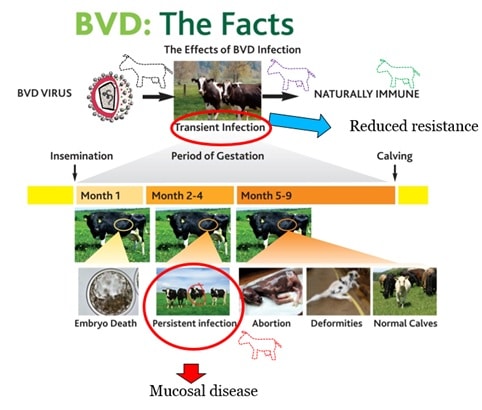- Bovine viral diarrhoea (BVD) is a highly contagious viral disease of cattle that can be transmitted as easily as the common cold. It can be spread directly by infected animals, or indirectly, for example by contaminated visitors or equipment.
- The majority of infections with BVD virus occur after birth. In this case animals become transiently infected (TI) before recovering and becoming virus-negative, typically within 3 weeks or less. Transient infections may occur without obvious clinical signs but depending on age, sex and immunity they can lead to a range of reproductive problems, including abortion and poor calf health with scours and pneumonias that respond poorly to treatment.
- Infection of the unborn calf between approximately 30 and 120 days of pregnancy will result in it becoming persistently infected (PI) with BVD virus if the calf is not aborted. If a calf is not PI at birth it will never be PI.
- These PI animals will shed BVD virus at high levels for life and PI animals are therefore the most significant source of infection. TI animals shed virus at much lower levels and only for a few days.
- TI calves may also test positive for BVD virus. However, due to the immune response in TI calves a repeat test 3-4 weeks later should be negative, whereas a PI should always give a positive result. It is expected that around 0.6-0.7% (6-7 calves per 1,000) will test positive for BVD virus.
- PI animals can look entirely normal, particularly at birth, but may become stunted and ill-thriven. PI animals often develop a severe and always fatal wasting condition with diarrhoea and ulceration of the gut and feet, called mucosal disease (MD). This typically occurs between 6 and 18 months of age. The majority of PI animals are dead before reaching breeding age or slaughter weight, either from MD or other infections (particularly scour and pneumonia).
- BVD virus persists in herds by creating further PI calves. Therefore identification and removal of PI cattle is the key to control. Vaccination to maintain immunity in breeding stock can offer further protection where susceptible pregnant cattle are exposed to BVD virus.
- BVD eradication makes financial sense. A recent study estimated that the programme in the Republic of Ireland would give a cost benefit of 10:1 over the six years of the programme i.e. a return of ten euro for each one spent.



